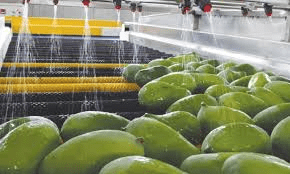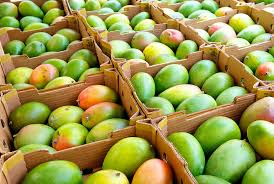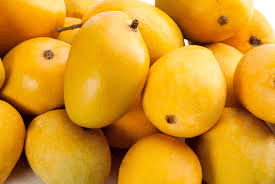Exporting mangoes involves a series of careful steps to ensure that they reach international markets in optimal condition. To process mangoes for exportation, start by selecting ripe but firm mangoes that are free from bruises and have a uniform size and color. Next, wash the mangoes thoroughly to remove dirt and contaminants, using clean water and, if needed, a mild disinfectant.
After washing, sort the mangoes based on size, color, and ripeness to ensure consistency in quality and appearance. If you are exporting mango slices or pulp, peel and cut the mangoes into the desired shapes using sharp, clean knives to minimize damage. For slices, blanch them briefly in hot water to preserve their color, texture, and flavor.
Immediately cool the mangoes in ice water after blanching to stop the cooking process and retain freshness. Pack the mangoes in clean, food-grade containers; use vacuum-sealed bags for slices or pulp and breathable crates or boxes for whole mangoes. Label each package with necessary information such as the variety, weight, packing date, and origin to ensure traceability and compliance.
Pre-cool the packed mangoes to the recommended temperature to maintain freshness and extend shelf life. Store the mangoes in a cool, dry place until ready to be shipped, and conduct a final quality check to ensure that all mangoes meet export standards.
Prepare the necessary export documents, including phytosanitary certificates, commercial invoices, and packing lists, to ensure smooth customs clearance. Finally, arrange for transport using refrigerated containers to maintain the required temperature during transit and ensure compliance with the import regulations of the destination country.
How to Process Mangoes for Exportation

1. Selection: Choose mangoes that are ripe but firm, free from bruises, and have a uniform size and color. This ensures that only high-quality mangoes are selected for export.
2. Washing: Thoroughly wash the mangoes to remove dirt, pesticides, and other contaminants. Use clean water and a mild disinfectant if necessary.
3. Sorting: Sort the mangoes based on size, color, and ripeness. This helps in maintaining consistency in quality and appearance for export.
4. Peeling and Cutting (if needed): If exporting mango slices or pulp, peel and cut the mangoes into the desired shapes. Use sharp, clean knives to ensure smooth cuts and minimize damage.
5. Blanching (if needed): Blanch mango slices in hot water for a short period. This step helps to preserve color, texture, and flavor during storage and transport.
6. Cooling: Immediately cool the mangoes after blanching using ice water. This stops the cooking process and helps in retaining freshness.
7. Packaging: Pack the mangoes in clean, food-grade containers. Use vacuum-sealed bags for slices or pulp, and breathable crates or boxes for whole mangoes to ensure proper air circulation.
8. Labeling: Label each package with the necessary information, including the variety of mango, weight, date of packing, and origin. This ensures traceability and compliance with export regulations.
9. Pre-Cooling: Pre-cool the packed mangoes to the recommended temperature for transport. This helps in maintaining freshness and extending shelf life.
10. Storage: Store the mangoes in a cool, dry place until they are ready to be shipped. Proper storage conditions help in preserving the quality of mangoes.
11. Quality Control: Conduct a final quality check to ensure that all mangoes meet the export standards. Remove any damaged or substandard fruits.
12. Documentation: Prepare the necessary export documents, including phytosanitary certificates, commercial invoices, and packing lists. This ensures smooth customs clearance.
13. Transport: Arrange for the transport of mangoes to the export destination. Use refrigerated containers to maintain the required temperature during transit.
14. Compliance: Ensure compliance with the import regulations of the destination country. This includes adhering to quarantine requirements and food safety standards.
Read Also: Importance of Rabbit Urine and How to Use it
How to Package Mangoes for Exportation

1. Selection of Packaging Material: Choose appropriate packaging materials that protect mangoes during transit. Use breathable crates for whole mangoes and vacuum-sealed bags for slices or pulp.
2. Cleaning Packaging Material: Ensure all packaging materials are clean and free from contaminants. This helps in maintaining the hygiene of the packaged mangoes.
3. Layering: For whole mangoes, layer them in crates with padding to prevent bruising. Use soft, cushioning materials like shredded paper or foam.
4. Sealing: For mango slices or pulp, use vacuum-sealed bags to maintain freshness and prevent oxidation. Ensure the bags are properly sealed to avoid leakage.
5. Weight Check: Weigh each package to ensure they meet the export weight requirements. This ensures consistency and helps in calculating shipping costs.
6. Labeling: Label each package clearly with necessary information, including the variety, weight, date of packing, and origin. This aids in identification and traceability.
7. Pre-Cooling: Pre-cool the packed mangoes to the recommended temperature before shipping. This helps in preserving freshness and extending shelf life.
8. Palletizing: Arrange the packages on pallets for easier handling and transport. Secure the packages with straps or shrink wrap to prevent movement during transit.
9. Quality Check: Conduct a final quality check to ensure all packages meet the export standards. Remove any damaged or substandard packages.
10. Documentation: Attach the necessary export documents, including phytosanitary certificates, commercial invoices, and packing lists, to the packages. This ensures smooth customs clearance.
How to Export Mangoes for Profits
1. Market Research: Conduct thorough research on potential markets for mango export. Identify countries with high demand for mangoes and favorable trade conditions.
2. Compliance with Regulations: Ensure compliance with the export regulations of your country and the import regulations of the destination country. This includes obtaining necessary permits and certificates.
3. Quality Assurance: Maintain high-quality standards for mangoes to build a good reputation in the export market. Consistent quality helps in retaining customers and gaining new ones.
4. Pricing Strategy: Set competitive prices for your mangoes based on market research. Consider factors like production costs, shipping costs, and market demand.
5. Building Relationships: Build strong relationships with buyers and distributors in the target markets. Good relationships can lead to repeat business and referrals.
6. Branding and Marketing: Create a strong brand identity for your mangoes. Use marketing strategies like social media, online marketplaces, and trade fairs to promote your mangoes.
7. Logistics Planning: Plan the logistics for transporting mangoes to the export destination. Choose reliable shipping companies that offer refrigerated containers to maintain the quality of mangoes.
8. Insurance: Insure your shipments to protect against potential losses during transit. This provides financial security in case of damage or loss.
9. Payment Terms: Negotiate favorable payment terms with buyers. Consider options like letters of credit or advance payments to ensure timely payment.
10. Continuous Improvement: Continuously monitor and improve your export processes based on feedback from buyers and market trends. This helps in staying competitive and maximizing profits.
Read Also: Common Rabbit Diseases and How to Cure them
Frequently Asked Questions (FAQs) About Mangoes

1. What is the best time to harvest mangoes for export?
The best time to harvest mangoes for export is when they are mature but not fully ripe. This ensures they ripen perfectly during transit and reach the destination in good condition.
2. How do I determine the quality of mangoes for export?
Quality is determined by factors like size, color, firmness, and absence of bruises or blemishes. Only mangoes that meet these standards should be selected for export.
3. What are the common packaging materials used for exporting mangoes?
Common packaging materials include breathable crates for whole mangoes and vacuum-sealed bags for mango slices or pulp. These materials help in maintaining freshness and preventing damage during transit.
4. How should mangoes be stored before export?
Mangoes should be stored in a cool, dry place with proper ventilation. Pre-cooling the mangoes before storage helps in preserving their freshness and extending shelf life.
5. What documents are required for exporting mangoes?
Required documents typically include phytosanitary certificates, commercial invoices, packing lists, and any necessary export permits. These documents ensure compliance with export and import regulations.
6. How can I find buyers for my mangoes in international markets?
Finding buyers can be done through online marketplaces, trade fairs, and networking with distributors and importers in target markets. Building relationships with buyers is key to successful export.
7. What are the common challenges in exporting mangoes?
Common challenges include maintaining quality during transit, complying with different countries’ import regulations, and managing logistics and shipping costs.
8. How can I ensure my mangoes meet import regulations of the destination country?
Ensure compliance by understanding the import regulations of the destination country, obtaining necessary permits and certificates, and adhering to quality standards.
9. What are the benefits of pre-cooling mangoes before export?
Pre-cooling helps in maintaining the freshness of mangoes, preventing spoilage, and extending their shelf life during transit.
10. How can I improve the profitability of my mango export business?
Improve profitability by maintaining high-quality standards, building strong relationships with buyers, optimizing logistics, and continuously monitoring and improving your processes based on market trends and feedback.
Read Also: Guide to Waste Management Industry Trends

